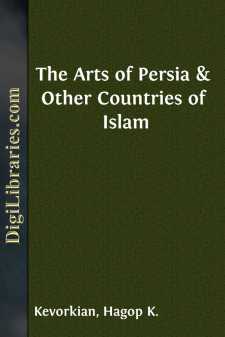Categories
- Antiques & Collectibles 13
- Architecture 36
- Art 48
- Bibles 22
- Biography & Autobiography 813
- Body, Mind & Spirit 142
- Business & Economics 28
- Children's Books 17
- Children's Fiction 14
- Computers 4
- Cooking 94
- Crafts & Hobbies 4
- Drama 346
- Education 46
- Family & Relationships 57
- Fiction 11829
- Games 19
- Gardening 17
- Health & Fitness 34
- History 1377
- House & Home 1
- Humor 147
- Juvenile Fiction 1873
- Juvenile Nonfiction 202
- Language Arts & Disciplines 88
- Law 16
- Literary Collections 686
- Literary Criticism 179
- Mathematics 13
- Medical 41
- Music 40
- Nature 179
- Non-Classifiable 1768
- Performing Arts 7
- Periodicals 1453
- Philosophy 64
- Photography 2
- Poetry 896
- Political Science 203
- Psychology 42
- Reference 154
- Religion 513
- Science 126
- Self-Help 84
- Social Science 81
- Sports & Recreation 34
- Study Aids 3
- Technology & Engineering 59
- Transportation 23
- Travel 463
- True Crime 29
The Arts of Persia & Other Countries of Islam
Categories:
Description:
Excerpt
THIS exhibition has been arranged with a desire to meet the convenience of those who are interested in manifestations of the arts of different countries over which Islam held sway at one time or other in the past. An effort has been made to show under one roof representative examples of works produced at different epochs and stages of the civilizations referred to, so that they may be seen, and perhaps studied, with the minimum expenditure of time.
Fine examples of many branches of the arts of these peoples are in permanent exhibitions at the Metropolitan Museum, New York, and the museums of great cities throughout the country. It is difficult to find adequate words to describe the enchanting atmosphere of the halls at the Metropolitan Museum where Near Eastern art is installed; and the same can truly be said of the Museum of Fine Arts, Boston, and the University of Pennsylvania Museum, Philadelphia. These exhibitions must inevitably contribute to the enjoyment and education of countless visitors to these institutions, and will continue to do so in increasing degree to the enjoyment of generations to come.
The present exhibition does not comprise a vast number of objects. Its claim to attention lies in the fact that it includes an important series of really first class works which are also of great historical importance. There will be on view as well some comparatively new types of objects of æsthetic and archæological interest, obtained as the result of recent excavations.
The briefness of time available precluded the possibility of compiling a catalogue, as was at first intended. The present booklet is issued to explain the scope of the exhibition, and extend a cordial invitation to visit it.
H.K.
[Enlarge]
MUHAMMAD (THE PROPHET) WITNESSES ALI (HIS SON-IN-LAW AND SUCCESSOR) DEFEAT AMR BEN ABDWAD
One of the eight illustrations for a XIIIth Century Persian Manuscript entitled, "History of Tabari", compiled A.H. 310 (A.D. 922). The present copy is a subsequent one of the Persian version, translated by al B'ala'mi, A.H. 352.
It is interesting to note that Tabari records in the book here referred to, that three messages were sent by Muhammad to Khusraw Parniz, imparting the divine warnings. One of the messages, as recorded in an old Manuscript entitled Nihayat ul-Irab, reads:
"In the name of God, the merciful, the compassionate. From Muhammad the Apostle of God to Khusraw son of Hurmazd. But to proceed. Verily I extol unto thee God, beside whom there is no other God. He it is who guarded me when I was an orphan, and made me rich when I was destitute, and guided me when I was straying in error. Only he who is bereft of understanding, and over whom calamity triumphs, rejects the message which I am sent to announce. O Khusraw, submit and thou shalt be safe, or else prepare to wage with God and with his Apostle a war which shall not find them helpless. Farewell."
The rise of Islam and its rapid advent to power, is perhaps the most surprising chapter of the history of mankind. The great empires, Persian and Byzantine, which were subjected to the urgent onslaught of this rising power may have been in an enfeebled condition as a result of excess of despotism and internal dissensions, as historians affirm; but that the element of the power must have been in the rationality of the principles contained in the teaching, there can be no doubt.
"It was undoubtedly to Islam, that simple yet majestic creed of which no unprejudiced student can ignore the grandeur, that Arabs owed the splendid part which they were destined to play in the history of civilization....


